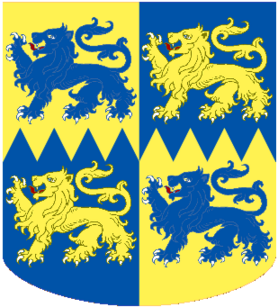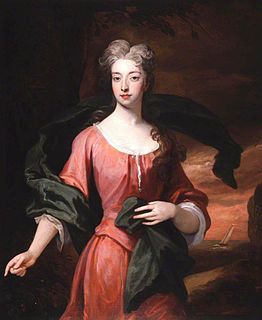
Marquess of Rockingham, in the County of Northampton, was a title in the Peerage of Great Britain. It was created in 1746 for Thomas Watson-Wentworth, 1st Earl of Malton. The Watson family descended from Lewis Watson, Member of Parliament for Lincoln. He was created a Baronet, of Rockingham Castle in the County of Northampton, in the Baronetage of England in 1621. In 1645 he was further honoured when he was raised to the Peerage of England as Baron Rockingham. The third Baron served as Lord-Lieutenant of Kent. In 1714 he was created Baron Throwley, Viscount Sondes and Earl of Rockingham in the Peerage of Great Britain. His eldest son Edward Watson, Viscount Sondes, predeceased him and he was succeeded by his grandson, the second Earl. The second Earl was Lord-Lieutenant of Kent before his early death in 1745. He was childless and was succeeded by his younger brother, Thomas. He had previously represented Canterbury in Parliament. He died in 1746, whereupon the barony of Throwley, viscountcy and earldom became extinct.
The Peerage of the United Kingdom comprises most peerages created in the United Kingdom of Great Britain and Ireland after the Acts of Union in 1801, when it replaced the Peerage of Great Britain. New peers continued to be created in the Peerage of Ireland until 1898.

Earl of Abingdon is a title in the Peerage of England. It was created on 30 November 1682 for James Bertie, 5th Baron Norreys of Rycote. He was the eldest son of Montagu Bertie, 2nd Earl of Lindsey by his second marriage to Bridget, 4th Baroness Norreys de Rycote, and the younger half-brother of Robert Bertie, 3rd Earl of Lindsey. His mother's family descended from Sir Henry Norris, who represented Berkshire and Oxfordshire in the House of Commons and served as Ambassador to France. In 1572 he was summoned by writ to Parliament as Lord Norreys de Rycote. He was succeeded by his grandson, the second Baron. In 1621 he was created Viscount Thame and Earl of Berkshire in the Peerage of England. He had no sons and on his death in 1624 the viscountcy and earldom became extinct. He was succeeded in the barony by his daughter Elizabeth, the third holder of the title. On her death the title passed to her daughter, the aforementioned Bridget, the fourth Baroness, second wife of the second Earl of Lindsey.

Marquess of Headfort is a title in the Peerage of Ireland. It was created in 1800 for Thomas Taylour, 2nd Earl of Bective.
The title of Viscount Mountjoy has been created three times, twice in the Peerage of Ireland and once in the Peerage of Great Britain. The creations in the Peerage of Ireland were made in 1683 and 1795, and became extinct in 1769 and 1829, respectively. The creation in the Peerage of Great Britain occurred in 1796, as a subsidiary title for the Marquess of Bute, to which title it is still attached.

Earl of Macclesfield is a title that has been created twice. The first creation came in the Peerage of England in 1679 in favour of the soldier and politician Charles Gerard, 1st Baron Gerard. He had already been created Baron Gerard, of Brandon in the County of Suffolk, in 1645, and was made Viscount Brandon, of Brandon in the County of Suffolk, at the same time as he was given the earldom. These titles are also in the Peerage of England. Lord Macclesfield was the great-grandson of the distinguished judge Sir Gilbert Gerard, Master of the Rolls from 1581 to 1594. He was succeeded by his eldest son, the second Earl. He was involved in the Rye House Plot of 1683, was sentenced to death but later pardoned by the King. On his death without legitimate issue in 1701 the titles passed to his younger brother, the third Earl. He had earlier represented Yarmouth, Lancaster and Lancashire in the House of Commons. When he died in 1702 the titles became extinct.
Baron Cromwell is a title that has been created several times in the Peerage of England. The first creation, which was by writ, was for John de Cromwell in 1308. On his death, the barony became extinct. The second creation came in 1375 when Ralph de Cromwell was summoned by writ to Parliament as Lord Cromwell. His grandson, the third baron, served as Lord High Treasurer to King Henry VI. However, on his death in 1455 the barony fell into abeyance between his nieces Maude and Joan. On Joan's death in 1490 the abeyance was terminated in favour of Maude, the fourth holder. When she died childless in 1497 the peerage once again fell into abeyance, this time between the daughters of the first baron. The title remained in abeyance for over 400 years. However, in 1922 the Committee for Privileges of the House of Lords reported in favour of the petition for the termination of the abeyancy of Selina Frances Bewicke-Copley. She was the daughter of Sir Charles Watson Copley, 3rd Baronet, and one of the co-heirs of Maud, daughter of the first baron Cromwell. Selina died in 1923 and in July of the same year the abeyance was terminated in favour of her son Robert Godfrey Wolesley Bewicke-Copley, who became the fifth baron. He notably served as Lord Lieutenant of Leicestershire. As of 2010 the ancient barony is held by his grandson, the seventh baron, who succeeded his father in 1982. Having lost his seat in the House of Lords under the House of Lords Act 1999, in April 2014 he was elected at a hereditary peers' by-election as a Crossbencher.

Viscount Charlemont is a title in the Peerage of Ireland. It was created in 1665 for William Caulfeild, 5th Baron Charlemont.

Earl of Clanricarde is a title that has been created twice in the Peerage of Ireland, first in 1543 and again in 1800. The former creation became extinct in 1916 while the 1800 creation is extant and held by the Marquess of Sligo since 1916.

Viscount Fauconberg, of Henknowle in the Bishopric of Durham, was a title in the Peerage of England held by the head of the Belasyse family. This family descended from Sir Henry Belasyse, High Sheriff of Yorkshire from 1603 to 1604, who was created a Baronet, of Newborough in the County of York, in the Baronetage of England in 1611. His son, Sir Thomas, the second Baronet, was created Baron Fauconberg, of Yarm in the County of York, in the Peerage of England in 1627. In 1643 he was further honoured when he was made Viscount Fauconberg, of Henknowle in the Bishopric of Durham, also in the Peerage of England. He was succeeded by his grandson, Thomas, the second Viscount, the son of the Honourable Henry Belasyse. Thomas was created Earl Fauconberg in the Peerage of England in 1689. He was childless and the earldom became extinct on his death in 1700. He was succeeded in the remaining titles by his nephew and namesake, Thomas, the third Viscount, the son of Sir Rowland Belasyse. The third Viscount was succeeded by his son, Thomas, the fourth Viscount, who in 1756 was created Earl Fauconberg, of Newborough in the County of York, in the Peerage of Great Britain. The Earl's son Thomas, the second Earl, had no sons and the earldom became extinct on his death in 1802. He was succeeded in the remaining titles by his second cousin Rowland Belasyse, the sixth Viscount, the grandson and namesake of Rowland Belasyse, younger brother of the third Viscount. The sixth Viscount was succeeded by his younger brother, Charles the seventh Viscount, on whose death in 1815 all the titles became extinct.
The titles of Baron Mountjoy and Viscount Mountjoy have been created several times for members of various families, including the Blounts and their descendants and the Stewarts of Ramelton and their descendants.
The Lord Deputy was the representative of the monarch and head of the Irish executive under English rule, during the Lordship of Ireland and then the Kingdom of Ireland. He deputised prior to 1523 for the Viceroy of Ireland. The plural form is Lords Deputy.
Viscount Castlecomer was a title created on 15 March 1707, along with the title Baron Wandesford, for Christopher Wandesford, 1st Viscount Castlecomer, whose father, Sir Christopher Wandesford, had been created Baronet of Kirklington, North Yorkshire on 5 August 1662 in the Baronetage of England. The 5th Viscount was created Earl Wandesford on 15 August 1758. All three titles and the baronetcy became extinct on his death in 1784.

Edward Cromwell, 3rd Baron Cromwell was an English peer. He was the son of Henry Cromwell, 2nd Baron Cromwell by his wife Mary, daughter of John Paulet, 2nd Marquess of Winchester and his first wife Elizabeth Willoughby. His grandfather, Gregory, son of Thomas Cromwell, chief minister to Henry VIII, was created Baron Cromwell on 18 December 1540.

Thomas Cromwell, 1st Earl of Ardglass was an English nobleman, son of Edward Cromwell, 3rd Baron Cromwell and second wife Frances Rugge.

Wingfield Cromwell, 2nd Earl of Ardglass, DCL, was an English nobleman, son of Thomas Cromwell, 1st Earl of Ardglass and Elizabeth Meverell. He held the subsidiary titles of 2nd Viscount Lecale and 5th Baron Cromwell of Oakham.

Thomas Cromwell, 3rd Earl of Ardglass, was an English nobleman, the only son of Wingfield Cromwell, 2nd Earl of Ardglass of Ilam, Staffordshire and Mary Russell. He held the subsidiary titles of 3rd Viscount Lecale and 6th Baron Cromwell of Oakham.

Vere Essex Cromwell, 4th Earl of Ardglass PC (I), was an English nobleman, son of Thomas Cromwell, 1st Earl of Ardglass and Elizabeth Meverell.

Lady Elizabeth Southwell, called Lady Cromwell (1674–1709) was an English noblewoman, the only daughter of Vere Essex Cromwell, 4th Earl of Ardglass and wife Catherine Hamilton.
The Cromwell family is an English aristocratic family. Its most famous members are: Thomas Cromwell, 1st Earl of Essex, and Oliver Cromwell, the Lord Protector. The line of Oliver Cromwell descends from Richard Williams, son of Thomas Cromwell's sister Katherine and her husband Morgan Williams.









